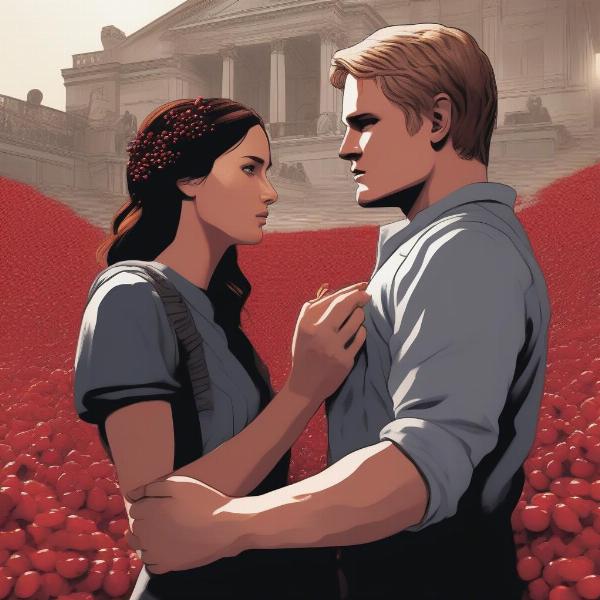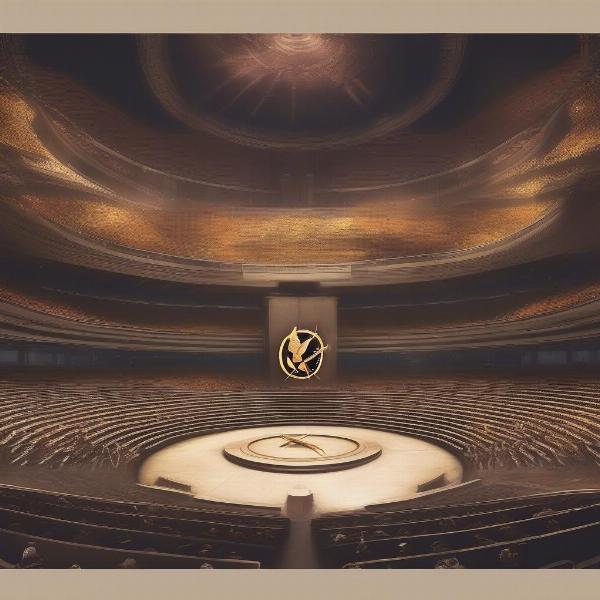The climax of The Hunger Games is a pivotal moment of intense action, suspense, and emotional turmoil that determines the fate of Katniss Everdeen and Peeta Mellark. It’s a scene etched into the minds of readers and viewers alike, leaving a lasting impact long after the story ends. But what exactly defines this crucial point in the narrative? Let’s delve into the heart of Panem and explore the defining moments that make up the climax of The Hunger Games.
The rising action builds steadily throughout the Games, with Katniss facing numerous challenges, from battling other tributes to navigating the treacherous arena itself. The Gamemakers manipulate the environment and introduce new threats, constantly escalating the tension. Katniss forms alliances, experiences loss, and demonstrates remarkable resilience, all contributing to the narrative momentum that propels us towards the climax. Her struggle for survival, intertwined with the budding romance with Peeta, keeps readers on the edge of their seats, wondering what will happen next.
The Rule Change and the Berries: The Peak of Tension
Arguably the most intense moment, and therefore the climax of the story, occurs when the Gamemakers announce a rule change: only one victor can emerge from the Games. This revocation of the previous two-victor rule throws Katniss and Peeta into a moral dilemma. They refuse to turn on each other, culminating in their simultaneous threat of suicide with poisonous nightlock berries. This act of defiance against the Capitol and the Games themselves represents the peak of the narrative tension. It forces the Gamemakers to back down, allowing both Katniss and Peeta to be crowned victors. This defiance resonates with the oppressed districts of Panem, planting the seeds of rebellion that will blossom in later installments of the series.
 Katniss and Peeta Holding Nightlock Berries
Katniss and Peeta Holding Nightlock Berries
Why is this the Climax?
This pivotal scene encapsulates all the core themes of The Hunger Games: survival, rebellion, and the power of love and defiance. It is the moment of greatest uncertainty, where the protagonists’ fates hang in the balance. The nightlock scene is the turning point of the story, marking the shift from a struggle for individual survival to a symbolic act of resistance against the oppressive regime. The consequences of this act ripple outward, influencing not only Katniss and Peeta’s future but also the entire trajectory of Panem. The dramatic tension built up throughout the Games reaches its peak here, making it undoubtedly the climax.
The Aftermath and its Significance
The aftermath of the climax solidifies its importance. The Capitol is furious with Katniss and Peeta’s defiance, setting the stage for the conflict in the subsequent books. Their victory is not a clean escape; it’s a spark that ignites a flame of rebellion across Panem. The climax is not simply the end of the Games; it’s the beginning of a revolution. The repercussions of their actions are felt immediately, with President Snow’s barely concealed anger foreshadowing the coming storm.
 Katniss and Peeta Crowned Victors
Katniss and Peeta Crowned Victors
Is there another possible climax? Some argue for the Muttations
Some might argue that the introduction of the mutated wolf-like creatures, or “muttations,” that resemble the deceased tributes, is another potential climax. This scene is undoubtedly intense and horrific, especially with the death of Cato. However, it lacks the same thematic weight and lasting impact as the nightlock scene. While it is a thrilling action sequence, it primarily serves to eliminate the remaining tributes and corner Katniss and Peeta, pushing them toward the true climax with the berries. It contributes to the rising action but doesn’t represent the peak of the narrative tension.
Understanding the Structure: Rising Action, Climax, Falling Action
To understand why the nightlock scene is the climax, it’s helpful to consider the traditional narrative structure of rising action, climax, and falling action. The Games themselves comprise the rising action, with each event escalating the tension. The nightlock scene is the peak, the point of no return, where the protagonists make their most significant and impactful decision. The falling action then follows, with the victors returning home and dealing with the consequences of their defiance.
 The Hunger Games Arena in Panem
The Hunger Games Arena in Panem
The Climax and the Theme of Rebellion: A Catalyst for Change
The climax of The Hunger Games is more than just a thrilling moment; it’s a powerful statement about rebellion and the courage to stand up for what you believe in, even in the face of overwhelming odds. This act of defiance sets the stage for the subsequent books, transforming Katniss and Peeta into symbols of hope and resistance for the oppressed people of Panem. It highlights the power of individual action to spark widespread change and challenge even the most formidable power structures. Similar to how Katniss and Peeta faced seemingly impossible odds, you can find out more about the motivations behind Cinna’s actions by checking out why did they kill cinna hunger games.
The Power of Defiance: Echoes throughout Panem
The nightlock scene resonates deeply with readers and viewers because it embodies the spirit of rebellion. It showcases the courage to challenge authority, even when the consequences seem insurmountable. It’s a reminder that even small acts of defiance can have significant and lasting impacts, especially when amplified by the collective will of the people. The climax of The Hunger Games is a testament to the power of hope and resistance in the face of oppression.
Conclusion
The climax of The Hunger Games, with the iconic nightlock scene, is a masterful example of narrative tension and thematic resonance. It’s a moment that defines the story, showcasing the characters’ courage, resilience, and the power of their defiance. It’s not just the culminating point of the Games themselves, but the catalyst for the rebellion that will shape the future of Panem. The berries become a symbol of hope, sparking a flame that will spread throughout the districts and ultimately challenge the very foundations of the Capitol’s power.
FAQ
-
What Is The Climax Of The Hunger Games? The climax is when Katniss and Peeta threaten suicide with nightlock berries rather than kill each other, forcing the Gamemakers to declare them both victors.
-
Why is the nightlock scene considered the climax? It’s the moment of highest tension, where the protagonists’ fates are most uncertain, and it has the most significant impact on the story’s overall trajectory.
-
Why isn’t the mutt attack the climax? While intense, the mutt attack is part of the rising action, leading up to the pivotal nightlock scene.
-
How does the climax contribute to the theme of rebellion? The defiance of Katniss and Peeta becomes a symbol of resistance against the Capitol, inspiring future rebellion.
-
What is the significance of the climax for the rest of the series? It sets the stage for the escalating conflict between the districts and the Capitol in the subsequent books.
-
What are the immediate consequences of the climax? The Capitol is angered by Katniss and Peeta’s defiance, setting the stage for their future struggles.
-
What does the nightlock symbolize? The nightlock berries become a symbol of hope, resistance, and the power of defiance against oppression.

